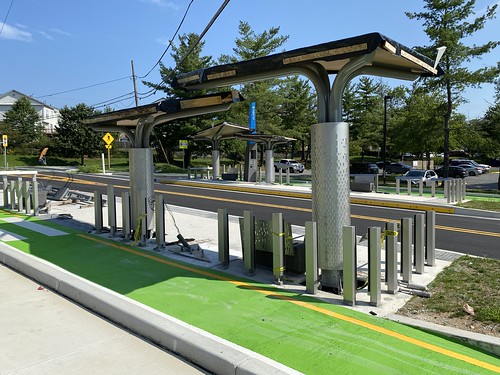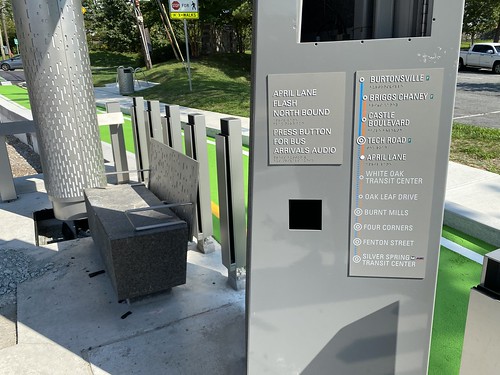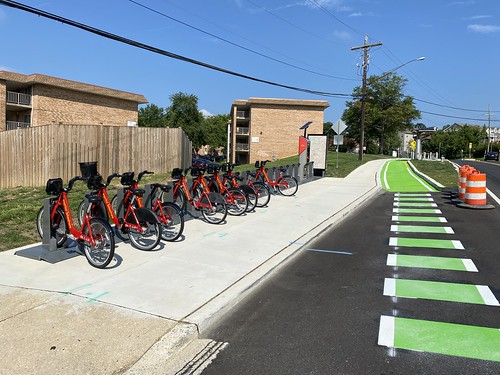 |
| The April Lane station on Flash, Maryland's first bus rapid transit line. Click here for a slideshow. All photos by the author. |
Under construction since 2018, Flash BRT is an 14-mile line that will run along Route 29 (Colesville Road and Columbia Pike) from the Silver Spring Metro station to Burtonsville, making 11 stops along the way.
It’s the first of three lines Montgomery County is working on - the other two are on Veirs Mill Road between Wheaton and Rockville, and along Route 355 between Bethesda and Clarksburg. Route 29 is one of the busiest bus corridors in the region, and Flash buses will come every 7.5 minutes during rush hour and run from 5am to midnight.
One of the stations will be April Lane, located on Lockwood Drive in White Oak where buses will briefly detour to serve a large cluster of apartment complexes. When I stopped by in August, the station (or stations, since there are platforms on both sides of the street) was almost finished, save for a few signs that hadn’t been installed and some construction debris.
 |
| A protected bike lane runs behind the Flash BRT station on April Lane. |
Each station has these distinctive canopies, which protect riders from the rain and sun and make the stations easier to find. There’s also a tall blue and gray pylon, which contains a route map and a screen with real-time updates on when the bus is coming.
To reduce travel time, riders will pay their fares at a machine in the station before getting on, and special traffic signals will give buses priority at intersections. The station platforms are slightly higher than the sidewalk and at the same level as the bus, allowing riders to walk or roll off smoothly.
As part of the federal grant Montgomery County received to build Flash, there are also new bicycling amenities. Ten Capital Bikeshare docks, several of which are at Flash stations, let people who live or work nearby bike to the bus. Lockwood Drive already had bike lanes, so the stations are built on a little island between the bike lane and the traffic lane.
“Floating bus stops” like this protect bicyclists from car traffic while also keeping them out of the way of buses pulling into the station. People walking to the Flash station cross the bike lane at little crosswalks next to the platform, similar to bus stops along the new Second Avenue bike lanes in downtown Silver Spring.
A loooong history
 |
| This pylon contains a map of the Flash BRT line. A screen showing real-time transit information will come later. |
The April Lane station is a good illustration of why Flash BRT is so important and why it’s been such a long time coming. Montgomery County first proposed building light rail along Route 29 in the 1980s, and the Planning Board rezoned large swaths of nearby land, including around April Lane, for apartments and townhomes so that people could live near it.
Yet rapid transit never came, beyond an express bus service that opened in 1985. Over time, a combination of white flight and the suburbanization of poverty made East County more racially and socioeconomically diverse. Instead of investing in better transportation, Montgomery County put the area in a development moratorium - basically a ban on new housing or businesses - for 18 years, due to opposition from community leaders who sometimes seemed uncomfortable with the area’s new diversity.
Today, East County still has lots of big homes that could easily pass for Potomac. But many people moved here for affordable homes next to a transit line that never got built, and are stuck in a community several miles from Metro, job centers, and other amenities. As a result, East County has higher poverty rates and worse economic outcomes than the rest of Montgomery County.
BRT could do a lot of good, if
 |
| 10 Capital Bikeshare stations were installed alongside the Flash BRT line. |
Flash BRT could help change that. A 2017 study predicts it will shorten travel times, reduce congestion, double transit ridership, increase access to jobs and economic opportunities, and support our nighttime economy. The line already appears to be attracting stuff, like the new White Oak Medical Center, a 180-bed hospital; a new Trader Joe's; and Viva White Oak, a research park with shops, offices, and housing. Drawing more investment to this area could improve racial equity in one of Montgomery County's most diverse communities.
What BRT won’t have, unfortunately, are dedicated bus lanes. Then-Montgomery County Councilmember Marc Elrich proposed a countywide network of Bus Rapid Transit routes in 2008, arguing that this was the fastest and most affordable way to address congestion.
Ever since then, residents from affluent neighborhoods near the line's southern end, like Woodmoor and Woodside Park, loudly fought them, because they didn’t want to give up space for cars on Route 29.
As a result, Flash buses will run on the shoulder of Route 29 between Burtonsville and New Hampshire Avenue, before merging into traffic with everyone else. Not only will this make the service slower and less reliable, but it could deter riders.
That might change. In 2017, residents Sean Emerson and Sebastian Smoot proposed a way to squeeze in bus lanes without taking away car lanes, and the Montgomery County Department of Transportation agreed to study it. This summer, MCDOT concluded that bus lanes would in fact speed up buses, but recommended looking at “managed lanes” that allowed buses and carpools, because it could reduce delays for drivers.
In the meantime, Flash buses are scheduled to start rolling through East County later this year. You can find out more, and get updates, at the Flash BRT website. You can also check out more photos here.

No comments:
Post a Comment